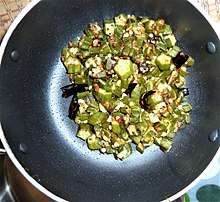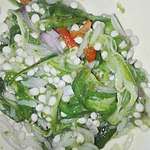Okra
Okra (US: /ˈoʊkrə/, UK: /ˈɒkrə/), Abelmoschus esculentus, known in many English-speaking countries as ladies' fingers or ochro, is a flowering plant in the mallow family. It is valued for its edible green seed pods. The geographical origin of okra is disputed, with supporters of West African, Ethiopian, and South Asian origins. The plant is cultivated in tropical, subtropical and warm temperate regions around the world.[2]
| Okra | |
|---|---|
| Okra plant with mature and developing fruits in Hong Kong | |
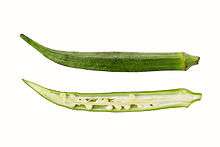 | |
| Okra in longitudinal section | |
| Scientific classification | |
| Kingdom: | Plantae |
| Clade: | Tracheophytes |
| Clade: | Angiosperms |
| Clade: | Eudicots |
| Clade: | Rosids |
| Order: | Malvales |
| Family: | Malvaceae |
| Genus: | Abelmoschus |
| Species: | A. esculentus |
| Binomial name | |
| Abelmoschus esculentus | |
| Synonyms[1] | |
| |
Etymology
'Abelmoschus' is New Latin from Arabic أَبُو المِسْك (ʾabū l-misk, “father of musk”).[3] 'esculentus' is Latin for being fit for human consumption.[4]
The first use of the word okra (Alternatively; okro or ochro) appeared on 1679 in the Colony of Virginia, deriving from the Igbo word ọ́kụ̀rụ̀.[5] The word gumbo was first recorded to be used in American vernacular around 1805, deriving from Louisiana Creole,[6] but originates from either the Umbundu word ochinggômbo[7] or the Kimbundu word ki-ngombo.[8] Despite the fact that in most of the United States the word gumbo often refers to the dish, gumbo, many places in the Deep South still use it to refer to the pods and plant as well as many other variants of the word found across the African diaspora in the Americas.[9]
Origin and distribution
Okra is an allopolyploid of uncertain parentage (proposed parents include Abelmoschus ficulneus, A. tuberculatus and a reported "diploid" form of okra). Truly wild (as opposed to naturalised) populations are not known with certainty and the species may be a cultigen. The geographical origin of okra is disputed, with supporters of South Asian, Ethiopian and West African origins. The Egyptians and Moors of the 12th and 13th centuries used the Arabic word for the plant, bamya, suggesting it had come into Egypt from Arabia, but earlier it was probably taken from Ethiopia to Arabia. The plant may have entered southwest Asia across the Red Sea or the Bab-el-Mandeb straight to the Arabian Peninsula, rather than north across the Sahara, or from India. One of the earliest accounts is by a Spanish Moor who visited Egypt in 1216 and described the plant under cultivation by the locals who ate the tender, young pods with meal.[10] From Arabia, the plant spread around the shores of the Mediterranean Sea and eastward. The plant was introduced to the Americas by ships plying the Atlantic slave trade[11] by 1658, when its presence was recorded in Brazil. It was further documented in Suriname in 1686. Okra may have been introduced to southeastern North America from Africa in the early 18th century. By 1748, it was being grown as far north as Philadelphia. Thomas Jefferson noted it was well established in Virginia by 1781. It was commonplace throughout the Southern United States by 1800, and the first mention of different cultivars was in 1806.[10]
Botany and cultivation

_cross-section_-_20080613.png)
The species is a perennial, often cultivated as an annual in temperate climates, often growing to around 2 metres (6.6 ft) tall. As a member of the Malvaceae, it is related to such species as cotton, cocoa, and hibiscus. The leaves are 10–20 centimetres (3.9–7.9 in) long and broad, palmately lobed with 5–7 lobes. The flowers are 4–8 centimetres (1.6–3.1 in) in diameter, with five white to yellow petals, often with a red or purple spot at the base of each petal. The pollens are spherical with approximately 188 microns diameter. The fruit is a capsule up to 18 centimetres (7.1 in) long with pentagonal cross-section, containing numerous seeds.
Abelmoschus esculentus is cultivated throughout the tropical and warm temperate regions of the world for its fibrous fruits or pods containing round, white seeds. It is among the most heat- and drought-tolerant vegetable species in the world and will tolerate soils with heavy clay and intermittent moisture, but frost can damage the pods. In cultivation, the seeds are soaked overnight prior to planting to a depth of 1–2 centimetres (0.39–0.79 in). It prefers a soil temperature of at least 20 °C (68 °F) for germination which occurs between six days (soaked seeds) and three weeks. Seedlings require ample water. The seed pods rapidly become fibrous and woody and, to be edible as a vegetable, must be harvested when immature, usually within a week after pollination.[12] Okra is available in two varieties, green and red. Red okra carries the same flavor as the more popular green okra and differs only in color. When cooked, the red okra pods turn green.
The most common disease afflicting the okra plant is verticillium wilt, often causing a yellowing and wilting of the leaves. Other diseases include powdery mildew in dry tropical regions, leaf spots, and root-knot nematodes.
Food and uses
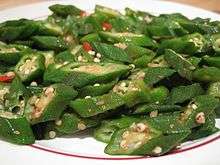
| Nutritional value per 100 g (3.5 oz) | |
|---|---|
| Energy | 138 kJ (33 kcal) |
7.46 g | |
| Sugars | 1.48 g |
| Dietary fibre | 3.3 g |
0.19 g | |
1.9 g | |
| Vitamins | Quantity %DV† |
| Vitamin A equiv. | 5% 36 μg |
| Thiamine (B1) | 17% 0.2 mg |
| Riboflavin (B2) | 5% 0.06 mg |
| Niacin (B3) | 7% 1 mg |
| Folate (B9) | 15% 60 μg |
| Vitamin C | 28% 23 mg |
| Vitamin E | 2% 0.27 mg |
| Vitamin K | 30% 31.3 μg |
| Minerals | Quantity %DV† |
| Calcium | 8% 82 mg |
| Iron | 5% 0.62 mg |
| Magnesium | 16% 57 mg |
| Phosphorus | 9% 61 mg |
| Potassium | 6% 299 mg |
| Zinc | 6% 0.58 mg |
| Other constituents | Quantity |
| Water | 89.6 g |
| |
| †Percentages are roughly approximated using US recommendations for adults. | |
The products of the plant are mucilaginous, resulting in the characteristic "goo" or slime when the seed pods are cooked; the mucilage contains soluble fiber.[13] One possible way to de-slime okra is to cook it with an acidic food, such as tomatoes, to render the mucilage less viscous.[14] Pods are cooked, pickled, eaten raw, or included in salads. Okra may be used in developing countries to mitigate malnutrition and alleviate food insecurity.[13]
Nutrition
Raw okra is 90% water, 2% protein, 7% carbohydrates and negligible in fat. In a 100 gram amount, raw okra is rich (20% or more of the Daily Value, DV) in dietary fiber, vitamin C and vitamin K, with moderate contents of thiamin, folate and magnesium (table).
Leaves and seeds
Young okra leaves may be cooked in a similar way to the greens of beets or dandelions, or in salads. Okra seeds may be roasted and ground to form a caffeine-free substitute for coffee.[10] When importation of coffee was disrupted by the American Civil War in 1861, the Austin State Gazette said, "An acre of okra will produce seed enough to furnish a plantation with coffee in every way equal to that imported from Rio."[15]
Greenish-yellow edible okra oil is pressed from okra seeds; it has a pleasant taste and odor, and is high in unsaturated fats such as oleic acid and linoleic acid.[16] The oil content of some varieties of the seed is about 40%. At 794 kg/ha, the yield was exceeded only by that of sunflower oil in one trial.[17] A 1920 study found that a sample contained 15% oil.[18] A 2009 study found okra oil suitable for use as a biofuel.[19]
Industrial uses
Bast fibre from the stem of the plant has industrial uses such as the reinforcement of polymer composites.[20] The mucilage produced by the okra plant can be used for the removal of turbidity from wastewater by virtue of its flocculent properties.[21][22] Having composition similar to a thick polysaccharide film, okra mucilage is under development as a biodegradable food packaging, as of 2018.[23]
Gallery
References
- "The Plant List: A Working List of All Plant Species". Retrieved 3 October 2014.
- National Research Council (2006-10-27). "Okra". Lost Crops of Africa: Volume II: Vegetables. Lost Crops of Africa. 2. National Academies Press. ISBN 978-0-309-10333-6. Retrieved 2008-07-15.
- "Definition of Abelmoschus". Merriam-Webster Dictionary. Retrieved 2020-06-23.
- "Latin definition for esculentus, esculenta, esculentum (ID: 19365)". Latin Dictionary and Grammar Resources - Latdict. 2020. Retrieved 2020-06-23.
- "Definition of okra". Merriam-Webster Dictionary. 2020. Retrieved 2020-06-23.
- Justin Vogt (2009-12-29). "Gumbo: The mysterious history". The Atlantic. Retrieved 2020-06-23.
- "Definition of gumbo". Merriam-Webster Dictionary. 2020. Retrieved 2020-06-23.
- "Many food names in English come from Africa". VOA. 2018-02-06. Retrieved 2020-06-23.
- Stanley Dry (2020). "A short history of gumbo". Southern Foodways Alliance. Retrieved 2020-06-23.
- ""Okra, or 'Gumbo,' from Africa". Texas AgriLife Extension Service, Texas A&M University.
- " Okra gumbo and rice" Archived 2005-10-28 at the Wayback Machine by Sheila S. Walker, The News Courier, unknown date
- Kurt Nolte. "Okra seed" (PDF). Yuma County Cooperative Extension. Retrieved 2012-10-17.
- Gemede, H. F.; Haki, G. D.; Beyene, F; Woldegiorgis, A. Z.; Rakshit, S. K. (2015). "Proximate, mineral, and antinutrient compositions of indigenous Okra (Abelmoschus esculentus) pod accessions: Implications for mineral bioavailability". Food Science & Nutrition. 4 (2): 223–33. doi:10.1002/fsn3.282. PMC 4779480. PMID 27004112.
- Jill Neimark (5 September 2018). "Leave it to botanists to turn cooking into a science lesson". US National Public Radio. Retrieved 26 June 2020.
- Austin State Gazette [TEX.], November 9, 1861, p. 4, c. 2, copied in Confederate Coffee Substitutes: Articles from Civil War Newspapers Archived September 28, 2007, at the Wayback Machine, University of Texas at Tyler
- Martin, Franklin W. (1982). "Okra, Potential Multiple-Purpose Crop for the Temperate Zones and Tropics". Economic Botany. 36 (3): 340–345. doi:10.1007/BF02858558.
- Mays, D.A., W. Buchanan, B.N. Bradford, and P.M. Giordano (1990). "Fuel production potential of several agricultural crops". Advances in New Crops: 260–263.CS1 maint: multiple names: authors list (link)
- Jamieson, George S.; Baughman, Walter F. (1920). "Okra Seed Oil.1". Journal of the American Chemical Society. 42: 166. doi:10.1021/ja01446a023.
- Farooq, Anwar; Umer Rashid; Muhammad Ashraf; Muhammad Nadeem (March 2010). "Okra (Hibiscus esculentus) seed oil for biodiesel production". Applied Energy. 87 (3): 779–785. doi:10.1016/j.apenergy.2009.09.020.
- De Rosa, I.M.; Kenny, J.M.; Puglia, D.; Santulli, C.; Sarasini, F. (2010). "Morphological, thermal and mechanical characterization of okra (Abelmoschus esculentus) fibres as potential reinforcement in polymer composites". Composites Science and Technology. 70 (1): 116–122. doi:10.1016/j.compscitech.2009.09.013.
- Konstantinos Anastasakis, Dimitrios Kalderis, and Evan Diamadopoulos (2009), "Flocculation behavior of mallow and okra mucilage in treating wastewater", Desalination, 249 (2): 786–791, doi:10.1016/j.desal.2008.09.013CS1 maint: multiple names: authors list (link)
- Monika Agarwal, Rajani Srinivasan, and Anuradha Mishra (2001), "Study on Flocculation Efficiency of Okra Gum in Sewage Waste Water", Macromolecular Materials and Engineering, 286 (9): 560–563, doi:10.1002/1439-2054(20010901)286:9<560::AID-MAME560>3.0.CO;2-BCS1 maint: multiple names: authors list (link)
- Araújo, Antonio; Galvão, Andrêssa; Filho, Carlos Silva; Mendes, Francisco; Oliveira, Marília; Barbosa, Francisco; Filho, Men Sousa; Bastos, Maria (2018). "Okra mucilage and corn starch bio-based film to be applied in food". Polymer Testing. 71: 352–361. doi:10.1016/j.polymertesting.2018.09.010. ISSN 0142-9418.
External links
| Wikimedia Commons has media related to Abelmoschus esculentus. |
| Wikibooks Cookbook has a recipe/module on |
| Look up okra in Wiktionary, the free dictionary. |
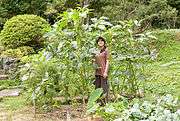


_(2).jpg)
